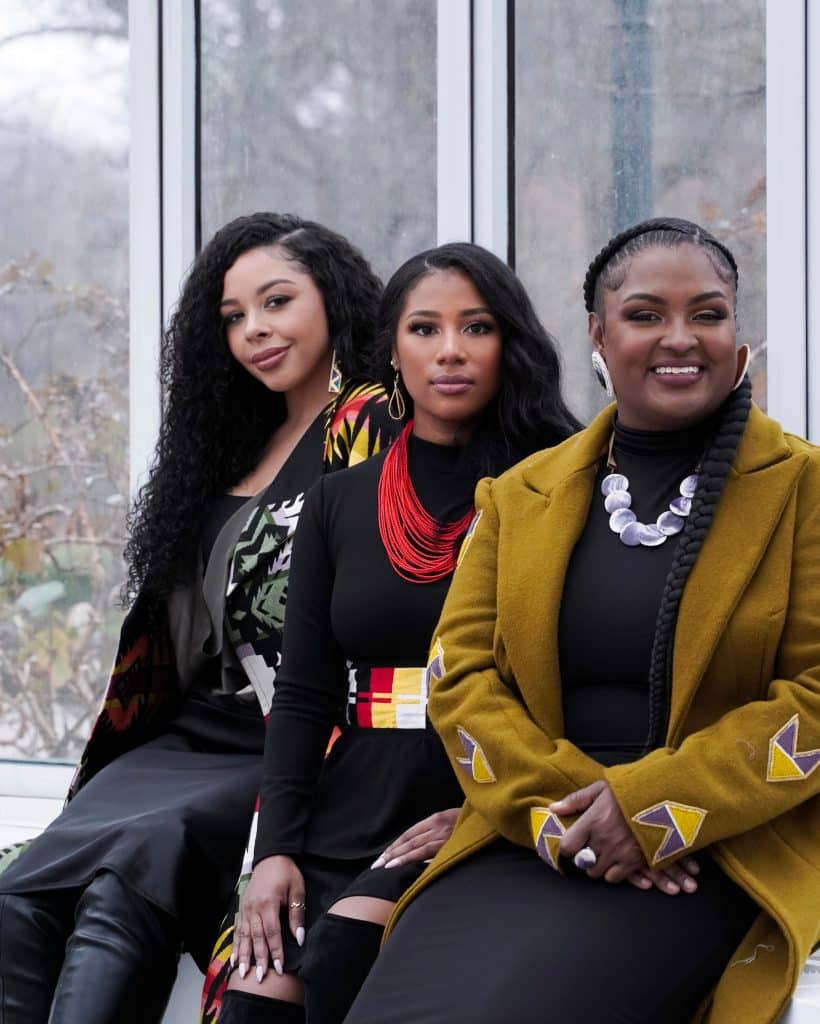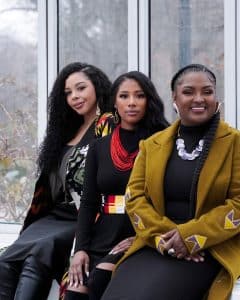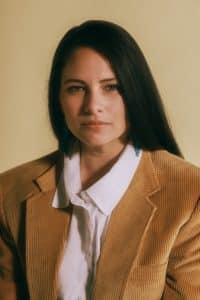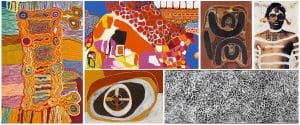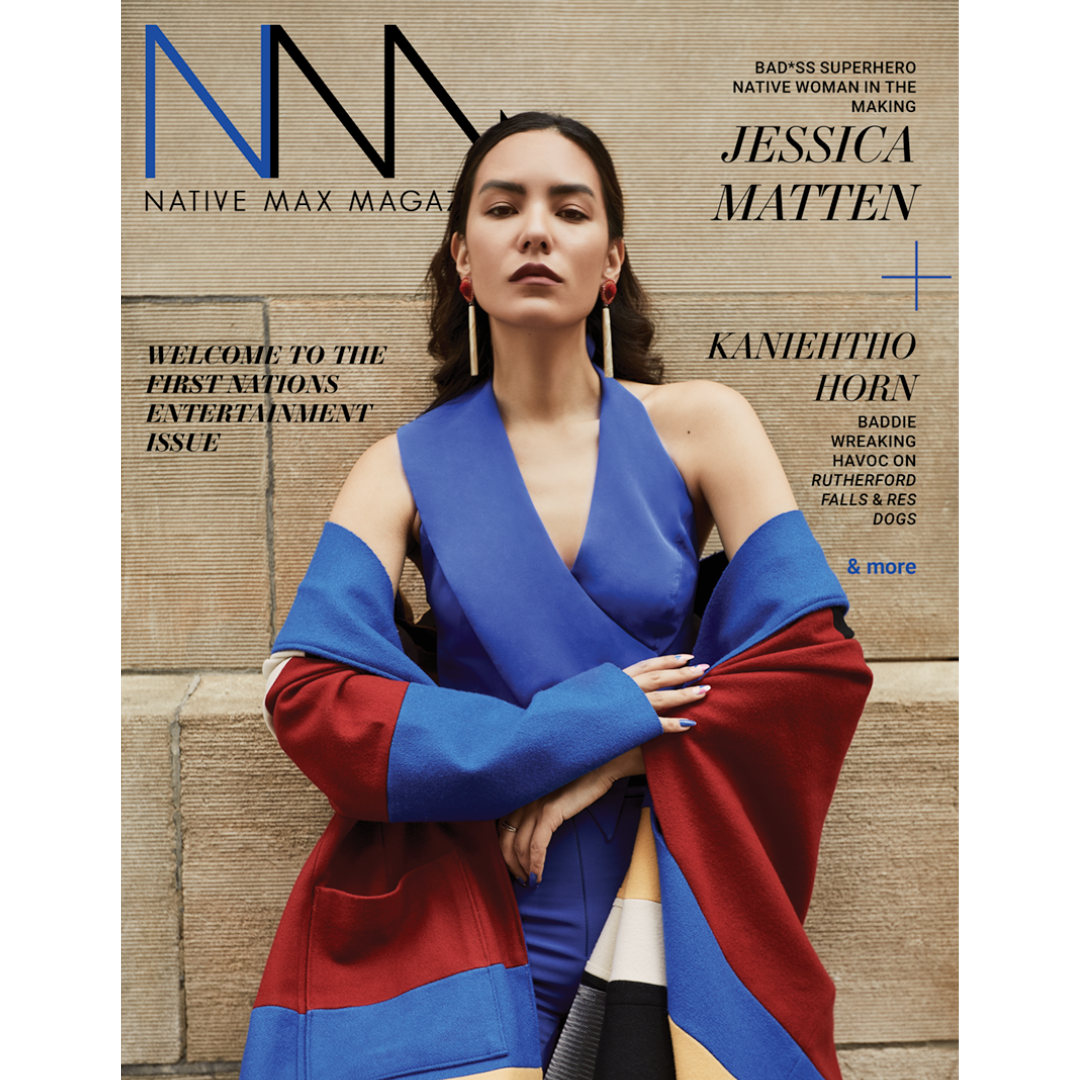Drawing from the depths of traditional knowledge, Tomasina Chupco, Chenae Netooeusqua Bullock, and Sutton King blend medicine, herbalism, and psychedelic insights into holistic healing. Their mission: to uplift and empower Indigenous communities, bridging Indigenous wisdom with contemporary knowledge. Their work kindles a flame of resilience, illuminating a path toward collective healing and cultural revival.
Tomasina Chupco
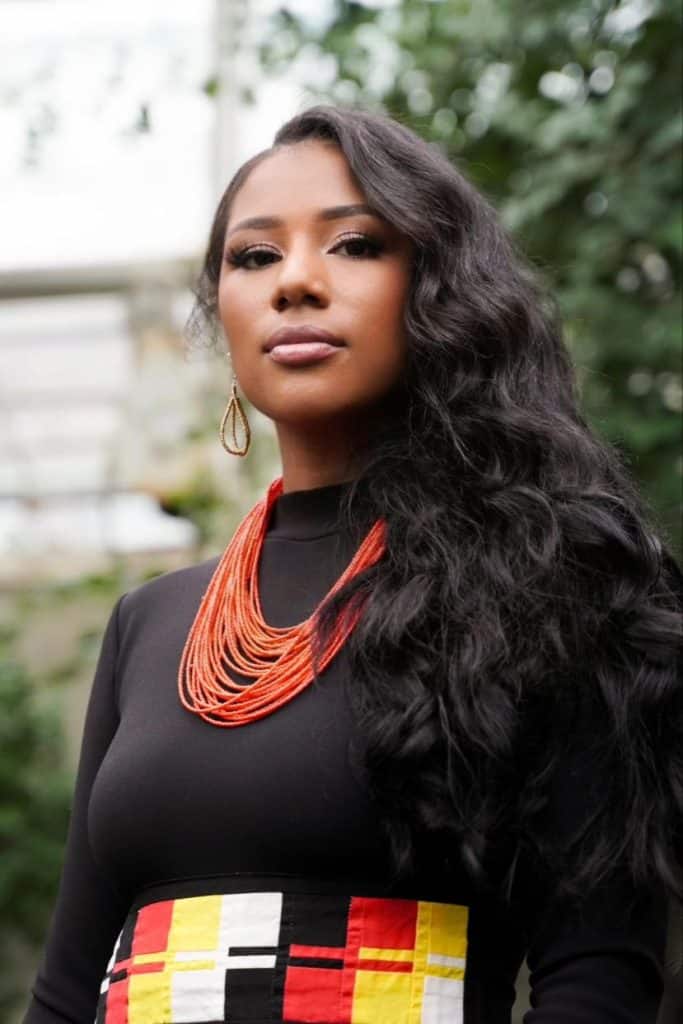
Through her passions for advocacy, healing, and medicine, Dr. Tomasina Chupco, Ed. D (Seminole and African-American) is promoting holistic wellness in style.
As an Indigenopathic Medicine Practitioner with a Bachelor of Science in Alternative Holistic Medicine and a Doctorate in Education, Tomasina Chupco’s work is rooted in uplifting and educating her communities in Indian Country and beyond. From Fort Pierce, Florida, Chupco founded Indigenous Intentions, a cause jewelry and BIPOC educational brand and community that’s about aesthetics and purpose. Indigenous Intentions specializes in limited edition cause jewelry, crafted with the intention of championing and uplifting Indigenous, Black, and Women’s causes. The brand’s roots in advocacy fuel its commitment to giving back to both Indigenous and Black communities, ensuring that every piece purchased becomes a testament to the causes Indigenous Intentions support. The brand proudly donates 100% of the proceeds from its MMIWG2+ collection to the National Indigenous Women Resource Center, with partnerships extending to organizations like StrongHearts Native Helpline, Indigenous Peoples Movement, Unicorn Riot, Black Visions Collective, COVID-19 Navajo Relief, Black and Missing Foundation, and more.
Chupco is also the co-chairwoman of the Healing The Circle In Our Tribal Communities Symposium, which focuses on traumas affecting Native communities. The three-day symposium included sessions of panels, an annual Domestic Violence Awareness Walk, a Healing Circle, and a Smudge Ceremony. The symposium’s goal was to initiate a healing process to combat the negative effects of colonization.
Tell us a little bit about yourself and your incredible work.
I founded Indigenous Intentions and Healing Hokte (Healing Woman). I hold a Doctorate in Education and a B.S. in Alternative Medicine, and am a licensed practitioner of Indigenopathic Medicine. My journey in jewelry-making and herbal medicine began in childhood, influenced by my Seminole family, especially my aunties and grandmother. My grandmother Marie Tommie taught me about herbalism and beadwork. We would travel to sell our crafts throughout the state.
What inspired your business, Indigenous Intentions?
Indigenous Intentions initially started as a fundraiser for a community initiative and turned into a cause-driven jewelry brand focusing on cultural and social causes. The brand donates a significant portion of proceeds from certain collections to organizations working towards these causes. It reflects an effort to support Black and Native communities, blending traditional beadwork with contemporary designs in our jewelry.
Healing Hokte started as an herbal initiative based on rest-is-resistance in advocacy. We focus on wellness and a sober-curious lifestyle through herbal medicine and Indigenous knowledge. The aim is to create quality, natural products. Our goal is to inspire individuals towards a healthier, more mindful lifestyle, positively impacting personal wellness and global advocacy.
Describe to us some of the products you sell at Indigenous Intentions. What are some popular items?
Our most popular jewelry product is our MMIWG2S+ collection, where 100% of proceeds go to the National Indigenous Women Resource Center. Our most popular herbal products are the Herbal Kisses, which are herbal flower smoke blends for those who are taking a tolerance break from tobacco, nicotine, and cannabis.
How does your work contribute to improving Indigenous health?
Through both initiatives, we contribute to Indigenous health by promoting wellness, sober curiosity, and advocacy, supporting various causes relevant to the well-being of Indigenous and Black communities.
What is the importance of cultural and environmental sustainability to you and your business? How do you incorporate Indigenous perspectives into this?
Cultural and environmental sustainability are fundamental to my work. I incorporate Indigenous perspectives by respecting traditional practices and ensuring our activities honor the cultural heritage and the environment. A day-by-day effort is important to contribute to an overall solution.
You do a lot of community and healing work with your business; why is it essential to remain sovereign and independent to ensure full service to your people?
My commitment to sovereignty and independence is essential for effectively serving Indigenous communities. My work emphasizes empowering and healing our communities through advocacy, cultural preservation, and supporting social causes.
What’s your solution for the global collective well-being of humanity?
My approach to global well-being involves community empowerment, cultural awareness, and advocacy. We strive to contribute through our initiatives for wellness/herbalism. Hopefully, we can host a retreat in the future with amazing Black and Native community members.
And of course, we have to talk about style and fashion! Who are you wearing in your look? How do you express yourself with your style and fashion, and why is it important?
I am wearing a pink satin diamond patchwork skirt made by the lovely Virginia Osceola and a black modern medicine color patchwork dress made by Stef Johns. Fashion is an important medium for me to express my Seminole and African-American heritage. My style choices are deeply rooted in my cultural identity. I love a good layered beaded necklace made by Indigenous Intentions, gold/silver bracelets with a satin patchwork skirt made by someone in my Tribe. I show up proudly, serving as an expression and advocacy for the causes I believe in.
Chenae Netooeusqua Bullock
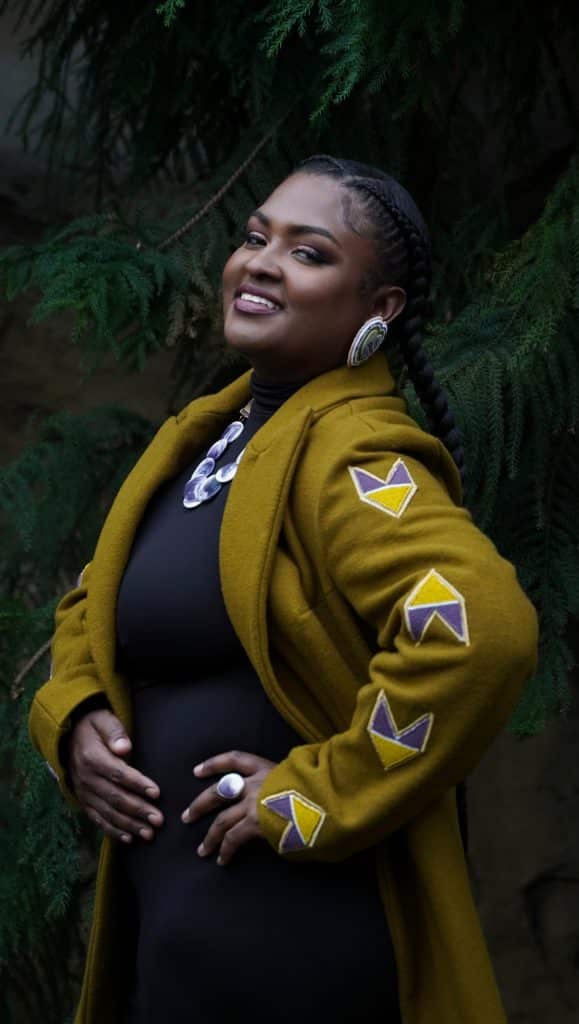
As an activist, entrepreneur, and consultant, Chenae Bullock, LPIM (Shinnecock and African-American) brings about healing for Indigenous communities.
Chenae Bullock is a licensed practitioner of Indigenopathic research (LPIM), an Indigenous perspective historian, a cultural moderator, a published author, and a public speaker. Bullock–known as Netooeusqua–founded Moskehtu Consulting LLC, an exclusive cultural and heritage firm that addresses the global urgency of social and environmental change.
Through Moskehtu Consulting, Netooeusqua provides consultancy services to bridge gaps between organizations and Native American communities by providing impactful initiatives and partnerships that address ecological and cultural tourism, environmental education, cultural competency, and sensitivity workshops, Indigenous consumer lifestyle marketing, tribal community engagement strategy, and more. Netooeusqua offers a collection of naturally-grown and harvested medicines that help with stress, anxiety, depression, and more with the Moskehtu Box. Every box contains bath tea, herbs, tea balls, wampum, sage, sweetgrass, and an Indigenous Perspectives Herbal Guide.
Most recently, Bullock published her book, “50 Plant Medicines: Indigenous Oral History & Perspective,” which invites readers to learn about plant medicines historically used by Native tribes. Her mission is to illuminate the view and understanding of Indigenous people through cultural competency in government and environmental spaces, brand partnerships, and pure connectivity to what she values most: humanity.
As an LPIM, Bullock contributes to her clients’ and partners’ social and environmental competence by improving their understanding of the natural world and preserving the original physicians’ ancient wisdom and sacred knowledge of enhanced healthcare under religious tribal law. Since the beginning of her life’s work in the world of arts, anthropology, and Indigenous studies, she’s engulfed in research and amplifying the voices of Indigenous peoples.
Tell us a little bit about yourself and your incredible work.
I am a culturally traditional Shinnecock woman. In the eyes of many, I have been told I am a community leader, water protector, cultural preservationist, Indigenous perspective historian, and humanitarian. I began much of my life’s work in the world of arts, anthropology, and indigenous studies, and I have been engulfed in research and amplifying the voices of Native peoples. My mission has been to illuminate the view and understanding of Indigenous people through cultural competency in government and environmental spaces, brand partnerships, and pure connectivity to humanity.
With experience transcending multiple industries, I have worked in accredited Indigenous museums, including the Shinnecock Indian Museum and Cultural Center, Plimoth Plantation, and the Mashantucket Pequot Museum and Research Center. Following my ancestor’s footsteps as whalers and business leaders, the foundation of her work has been based on the resurgence of the traditional canoe culture of the northeast coastal Algonquin communities. The bulk of my work has focused on the vitality of the region’s ocean ecosystem.
Recently, I was the Managing Director for Little Beach Harvest, a Cannabis business wholly owned by Shinnecock Nation, where I managed start-up costs of $18,000,000. I planned, developed, and operated a tribal-owned and tribal-regulated Cannabis retail operation in the Shinnecock Territory. November 15th, 2023, we cut the ribbon to open the business to the public.
I am also the Founder and CEO of Moskehtu Consulting, LLC, an Indigenous-owned and solely operated Cultural & Heritage Preservation firm. I grossed more than $200,000 in its first three years of operation. During the pandemic, I became a published author of her book, “50 Plant Medicines: Indigenous Oral History & Perspective,” which invites readers into a journey of learning about plant medicines historically used by the tribes in my ancestral homelands.
What inspired you to launch your business, Moskehtu?
After working in the public history industry as an Indigenous historian and interpreter, I experienced firsthand the erasure and continued paper genocide in the various institutions where I had to work. I recognize many non-native consulting firms were hired for the very work I and other Indigenous colleagues were not only qualified to do but lived every day as Indigenous people.
I established this company in February 2019 due to the lack of cultural competency and sensitivity due to the institutional voids in the governmental sectors, corporate sectors, and individual lives. As an Indigenous person who not only has the academic background regarding Indigenous people’s position when it comes to history and environmental issues, I live it every day. I have aimed to start a company that can consult with clients to create stewardships in these areas that affect everyone.
At Moskehtu Consulting, our key differentiator lies in the profound impact we create by fostering relationships between Indigenous people and various private and public entities. We apply ITEK (Indigenous Traditional Knowledge) combined with modern understanding to interrupt the blockages caused by historical events such as colonization. By doing so, we propel the economic, scientific, social, and technical advancement of society, leaving a lasting legacy of cultural and environmental preservation.
Describe some of the products you sell inside the Moskehtu box. Do you gather the medicines in the box?
In my tribal language, the word moskehtu translates to “medicine.” The box has loose herbs such as elderberry, echinacea, mullein, and burdock root. Each of the herbs is prepared separately and put in glass jars. There is a bath tea that I prepared that has rose petals, lavender, chamomile, thyme, and bath salts. There is a mesh tea ball to use to infuse the herbs. The added gifts I have put in the box include sweet grass, sage, cedar, and wampum. Some of the herbs and medicines I have foraged depend on the season and time of preparing the box. The others I ethically source from family or relatives across tribal communities. Each box is made ready to order.
This started during the pandemic when I made them to give away, and more people were inquiring. Because of the way I source and forage my medicines, I do not sell them all year long. I sell them when I have the supplies. The box also includes an Indigenous Knowledge guide on the uses of plant medicines, what they look like in their natural environment, and how to use the medicines in the box.
Tell us about the book “50 Plant Medicines: Indigenous Oral History & Perspective” you published. What can readers learn from it?
I wanted to write about plant medicines in a digital form to help as many people as I could become knowledgeable about the natural world. In 2020, the world had to slow down due to the pandemic, and more people were spending time in nature.
Before that year, I had spent a lot of time walking people on group plant identification walks and hiking tours. One of the most sought-after services of Moskehtu Consulting has been ecotourism. During the pandemic, my brother called me up and said, “Chenae, you need to make all of the things you do in nature accessible to people remotely somehow. So, one day, I sat still and started writing about the top fifty Indigenous plant medicines I am very familiar with. I realized so many people can talk about Indigenous plants and drink teas, but they do not know what these plants look like or where they grow in nature. Planetary health depends on people recognizing what we are trying to protect and preserve. My way of enlightening more people is to help them know what my ancestors passed down for us to learn about these plant medicines.
What is the importance of cultural and environmental sustainability to you and your business? How do you incorporate Indigenous perspectives into this?
The environment depends on our cultural sustainability because we are people of the earth. The melancholy feeling tradition indigenous culture people have is growing as fast as the fever from Mother Earth. Each day is a battle to continually battle the act of undermining the sovereignty of the sacred people of the earth. The flowing waters are weakening, the trees are losing their green life color, the relatives of all creations are endangered, and traditional Indigenous people are forced to become programmed into westernization and globalization. We must awaken the spirit we have been created with to be resistant to anyone who is still trying to assimilate us. We cannot assimilate anymore, or there will be no more sacred people left on this earth. We will all become AI.
The goal of Moskehtu Consulting is not simply to improve the current state of affairs but to fundamentally shift how the public perceives their surroundings. Our work is not just for our own benefit but for the benefit of future generations and the health of our planet.
You do a lot of community and healing work with your business; why is it essential to remain sovereign and independent to ensure full service to your people?
As Indigenous peoples, our teachings give us the foundation of our responsibilities on this earth. With those teachings, we understand that all life is related. Through the unfortunate physical assertion of colonialism in our cultural practices, our communities have become socially ill and have forgotten these teachings. This has become an emotional and spiritual dislocation and disorientation that becomes a major complication in life and throughout the entire community of a people. Once we can begin to heal the psychology of the layers of trauma, we can begin to remember those teachings. That is when we understand sovereignty and can live self-sufficiently as our ancestors did before settlement. Our people have begun that healing process since they were enslaved and forcefully assimilated, and over the years, we have been able to learn the laws and technologies that were used against our way of living to get back to our ancient teachings. This healing process for all Indigenous communities to do is vital to the well-being of our entire earth.
And of course, we have to talk about style and fashion! Who are you wearing in your look? How do you express yourself with your style and fashion, and why is it important?
My traditional clothing:
I am wearing a buckskin coat made by my mother and I. The designs I have painted on the coat represent my cultural identity as a Northeastern Coastal Algonquin woman. The whale tails honor the whales my family has had a close relationship with for thousands of years. I have wampum jewelry and pucker-toe moccasins representing my cultural identity as a Shinnecock Woman.
My contemporary outfit:
I am wearing a Klookinghorse coat handmade by Standing Rock Lakota fashion designer Kayla Lookinghorse. My earrings are from my Mattiecock relative, Tecumseh Ceaser, a traditional wampum maker in our community. My hair was braided by Kristine Goree, a Shinnecock relative, entrepreneur, and owner of Native Hair Visions Salon. My wampum necklace was made by a Mashpee Wampanoag relative and wampum artist, Wampon Moon. My wampum ring was made by a Pequot and Narragansett relative, Dan Simonds, owner of Wampum Wear.
Since I was a little girl, I have always understood the medicine of fashion. Both of my parents met in college at the Fashion Institute of Technology. My mother always took our traditions and incorporated them into the textiles. She made my clothes when I was a little girl and taught me what teachings were appropriate to share with others and what we kept sacred to our family. My dad helped me to understand how to tailor garments to be custom to who I am. He studied menswear and design. He helped me understand that my clothing can change a setting for the good or bad. My parents strongly influenced my love for fashion and taught me how to truly be myself by making what I put on custom to who I am. I had the best of both worlds growing up in a household with parents who understand clothing from a cultural standpoint and from an academic and industry standpoint.
Sutton King
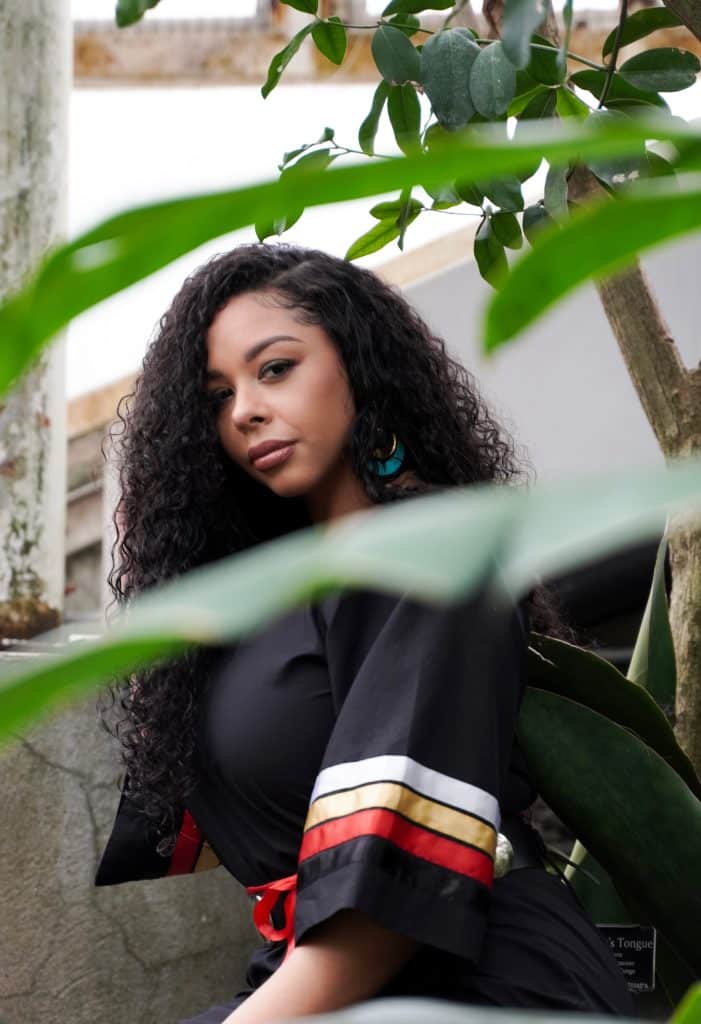
As one of the most influential women in psychedelics, Sutton King, MPH (Menominee, Oneida, and African-American) facilitates relationships between the budding psychedelic spaces and Indigenous traditional cultures that center Indigenous sovereignty.
Internationally recognized Indigenous rights activist, published researcher, and social entrepreneur Sutton King is dedicated to developing and scaling innovative solutions to improve Indigenous health equity across sectors. King’s (Menominee name is Nāēqtaw-Pianakiw) focus centers on access benefit sharing and culturally appropriate methodologies within technology, healthcare, and business. Not only does King advise organizations–big and small–on stakeholder models and accessing benefits and sharing through social impact investment and giving, she’s out to find innovative solutions that support mental health, women’s rights, drug policy reform, biocultural conservation while gaining national recognition along the way.
Tell us a little bit about yourself and your incredible work as an activist and entrepreneur.
I identify as Afro-Indigenous; my mother is Menominee, Oneida, and Irish, and my father is African American from the historic Africatown in Mobile, Alabama. As a child, the pow-wow circle called to me, and in that jingle dress, dancing was my medicine. With the influence of my mother, who worked for an Urban Indian Health Program, she managed a program called TRAIL, Together Raising Awareness for Indian Life. She taught children 8-12 drug and alcohol awareness and ensured they were connected to culture and community. She also taught diabetes awareness to elders to help them strengthen their relationship with food. From an early age, my mom empowered me in my Afro-Indigenous identity. She ensured I remained connected to culture and tradition, and through that, I understood the importance of medicine, our community, and the traditions we hold. As an Afro-indigenous woman, I have always felt like someone who has walked between different worlds: the Indigenous worldview and the Western worldview. I was always striving to maintain balance and advocate for the Indigenous peoples of this land and those who were removed from theirs.
This ability to walk in two worlds primarily comes from my ancestors. For the Menominee people, sustainability derives from the historical and cultural relationship with the land. My great grandfather, Chief Oshkosh (1795-1858) of the Menominee people, understood the importance of culture and tradition as the foundation of survival for our nation. As the settler state pressured the Menominee people to leave our ancestral homelands, Chief Oshkosh understood the dire consequences of removal. He exemplified a bridge between the community and the colonial state by strategically ceding 10 million acres to ensure that our people stayed connected to the land, our life source. Today, we are one of the few nations who remain on the ancestral land where our creation story began, a testament to Chief Oshkosh’s will to advocate in the name of community and cultural connectedness.
In recognizing the resilience embedded in my Menominee heritage, I also pay homage to my African ancestry, embracing the profound connection to Africatown, where my grandfather lived and worked. Africatown was founded by descendants of some of the enslaved people who arrived in America on the Clotilda, and it was the home to some of the last survivors of the transatlantic slave trade in the United States. Just as Chief Oshkosh navigated the challenges of his time, the founders of Africatown demonstrated a remarkable ability to forge community and maintain ties to their ancestral roots against colonial extractions and exploitation. The juxtaposition of these two ancestries underscores a universal truth – the strength derived from cultural continuity and a profound connection to the land.
I found my voice as an activist as a teenager after being accepted into an organization called Urban Underground. Urban Underground has been creating youth leaders in the Milwaukee area since 2000. Urban Underground advances a new generation of leaders committed to building safe and sustainable communities. The organization’s work reflects critical consciousness theory — the ability to recognize and understand inequality and the commitment to take action to dismantle the systems that encourage oppression. They saw a leader in me before I recognized the leader in myself. I recognized the importance of my black and native voice for the first time. Here, I learned how to create social justice campaigns and organize with my community to enact the change we wanted to see.
What inspired you to co-found Urban Indigenous Collective?
I co-founded Urban Indigenous Collective in 2019 to address a critical gap in culturally tailored and affordable healthcare services for Indigenous peoples in Lenapehoking (NYC) and the greater NYC area (New York, New Jersey, Connecticut, and Pennsylvania). My personal experience with chronic kidney disease and the challenges I faced in accessing appropriate healthcare after moving to NYC fueled my commitment to establishing an organization that prioritizes the well-being of our urban Indigenous community.
Determined to create a more inclusive and culturally sensitive approach, Urban Indigenous Collective is dedicated to decolonizing healthcare. Our mission focuses on supporting Indigenous peoples, irrespective of blood quantum or colonial borders, with a commitment to cultural humility. We aim to achieve this through community-based participatory research, advocacy, community programming, and direct services. UIC envisions a world where the rights and sovereignty of Indigenous Peoples are acknowledged and respected, incorporating continuous consent and free prior and informed consent as integral protocols in each of our programming areas.
Working holistically with traditional knowledge keepers and Western medicine, we strive to enhance our urban Indigenous community’s overall mental and physical well-being. Our vision includes a world where Urban Natives are visible in all spaces and have access to culturally appropriate resources that support healing and the pursuit of healthy lives. We are committed to modeling a future where Indigenous Peoples are empowered, and their unique needs are recognized and addressed with utmost respect and understanding.
Tell us a little bit about ShockTalk, another platform you co-founded.
ShockTalk is a cultural, telemental health platform designed for Native American and Alaska Native peoples. By leveraging a unique blend of social messaging channels, AI, and Zoom, ShockTalk creates and facilitates culturally appropriate patient-provider relationships with our Indigenous provider network.
ShockTalk is the first telemental health platform tailored specifically for Indigenous communities. ShockTalk is the first telemental health platform available to Indigenous peoples regardless of state or federal recognition status. ShockTalk administers telemental healthcare access through the social messaging channels most accessible to Indigenous communities. ShockTalk launched first on Facebook Messenger, with plans to expand to Instagram and SMS.
You also facilitate connections between the psychedelic spaces and Indigenous traditions and cultures. How do you do this work, and why is it important?
Plant medicines have played a critical role in my own liberation and healing. I view plant medicines as our relatives, relatives that we need to protect and defend against extraction and exploitation. We are now in a time called the “psychedelic renaissance.” Suppose the psychedelic sector develops in a “business as usual” fashion. In that case, this will not only perpetuate the current inequalities in today’s healthcare model but will also fundamentally oppose the transformational nature of plant medicines themselves. Indigenous peoples were criminalized and violated for their relationship with sacred plant medicines. It wasn’t until the American Indian Religious Freedom Act that Native Americans within the United States could legally sit in ceremonies and have a relationship with plant medicines. Now that the Western world sees our ways as a valid way to support mental health and an opportunity to profit, we must ensure appreciation is centered versus cultural appropriation. My advocacy has centered on protocols that respect indigenous voices, such as Free Prior and Informed Consent and the Nagoya protocol. FPIC is an essential building block of the rights of Indigenous people’s free, prior, and informed consent (FPIC). FPIC is woven into the fabric of the United Nations Declaration on the Rights of Indigenous Peoples (UNDRIP) – respect the drip! FPIC implies consultation before and participation in developing projects that impact their natural resources. While FPIC applies directly to projects that impact Indigenous peoples’ natural resources or real property, it also applies indirectly to projects that impact Indigenous peoples’ cultural resources or intellectual property.
In regards to the Nagoya Protocol, At the legal and political level, the international community has set up, with the Convention on Biological Diversity (CBD) agreed on in 1992 and entered in force in 1993, an international agreement to conserve biodiversity, a framework for regulating the access of users to this type of resource and sharing its monetary and non-monetary benefits with its providers, including national States party to the convention as well as indigenous and local communities having a record of preserving and developing knowledge about those resources, 196 national states have signed CBD. Despite the U.S. playing a significant role in drafting the CBD, the US is the only member of the United Nations yet to ratify it.
I was a part of the founding operations team of the Indigenous Medicine Conservation Fund (IMC Fund) and served as the Program Manager of Engagement and Benefit-sharing. I facilitated a relationship between the Psychedelic Space and Indigenous traditional cultures that centers on Indigenous sovereignty. In this role, I advised businesses ranging from startups to philanthropies on stakeholder models, access, and benefit sharing through social impact investment and giving. IMC Fund was co-created for the sovereign protection and regeneration of the medicines, ecologies & traditional knowledge Indigenous communities have honored for thousands of years. The Fund is a high-impact strategic fund created to ensure Indigenous communities and organizations succeed in their biocultural conservation efforts. Through community-based assessment and an Indigenous-led governance structure, the IMC Fund supports an integrated suite of biocultural conservation activities for five keystone medicines through empowering Indigenous organizations to conserve Ayahuasca, Bufo, Iboga, Peyote, and Mushrooms in their native territories.
Currently, I’m the co-founder of Common Field. Common Field empowers companies in the psychedelic industry through tailored education and facilitated training while promoting cultural humility and upholding ethical business protocols. We support the collective ability to heal by identifying a common field and centering bridebuilding. We envision a world where the practices of psychedelic therapy and Traditional Indigenous Medicine coexist and center Indigenous knowledge, challenging the assumptions of Western ontologies. Common Field supports an ethical economy through consultation, collaborative workshops, and informational resources. We and our partners are actively engaged in the process of bridge-building toward rightful and respectful engagement. Our distinctive approach is rooted in the profound commitment to our own unlearning, learning, and growth journeys.
How does your work contribute to improving Indigenous health?
The work across Urban Indigenous Collective (UIC), ShockTalk, and Common Field collectively improves Indigenous health by addressing multifaceted well-being, cultural humility, and community empowerment.
UIC focuses on providing and advocating for culturally tailored and affordable healthcare services, addressing a critical gap in the health needs of Indigenous peoples in the NYC urban setting. We are dedicated to decolonizing healthcare by prioritizing cultural humility, community-based participatory research, and direct services. This approach respects Indigenous traditions, regardless of blood quantum or colonial borders, fostering a more inclusive and respectful healthcare environment. The robust governance structure, including Indigenous-led and community advisory boards, ensures that the community’s voices and priorities are central to decision-making processes.
ShockTalk is specifically designed to address the mental health needs of Native American and Alaska Native peoples. The platform facilitates culturally appropriate patient-provider relationships through social messaging channels, AI, and Zoom, making mental health services more accessible and relatable. By being the first telemental health platform available to Indigenous peoples irrespective of state or federal recognition status, ShockTalk works to bridge gaps in mental health accessibility within Indigenous communities.
Common Field seeks to empower companies in the psychedelic industry through tailored education and training, promoting cultural humility and ethical business protocols. By challenging Western ontologies, the collective envisions a world where Indigenous knowledge is central to the practices of psychedelic therapy. Common Field stands in solidarity with Indigenous wisdom and ethical practices, prioritizing the well-being and agency of Indigenous communities. The collective fosters a space for unlearning, learning, and growth through ongoing dialogue and collaboration, centering Indigenous voices and perspectives.
Collectively, these initiatives contribute to Indigenous health by addressing immediate healthcare needs and fostering a holistic approach that respects cultural traditions, promotes mental well-being, and empowers Indigenous communities in shaping their health outcomes and stewarding their medicines.
What is the importance of cultural and environmental sustainability to you and your business? How do you incorporate Indigenous perspectives into this?
Cultural and environmental sustainability are foundational principles for me as a founder, and they resonate deeply with the values I hold and how I build all of my businesses. My commitment to these principles is rooted in the profound connection between land and culture, as exemplified by my tribe’s teaching on sustainable forestry.
For the Menominee people, the relationship between land and culture has also been shown through our relationship with our forests. Our forests provide us with game for food, wood for shelter and transportation, and plants to use as medicine for healing, making the land a vital part of our kinship system. A healthy forest is directly proportional to a healthy community, as health and land are considered one. As stewards of the forest, ancestral teachings from my grandfather instructed our people never to take more than what we need. Today, these teachings are recognized globally as sustainable forestry.
“Start harvesting the trees with the rising sun and work toward the setting sun, but take only the mature trees, the sick trees, and the trees that have fallen. When you reach the end of the reservation, turn and cut from the setting sun to the rising sun, and the trees will last forever.”
—Attributed to Chief Oshkosh, Menominee Nation (Menominee Tribal Enterprises, 2021)
The Menominee people have demonstrated walking in two worlds by leveraging traditional knowledge and scientific methodologies. Our cultural knowledge has sustained the biodiversity in what is known as one of the healthiest timber forests in North America. Using this principle of kinship to maintain sustainability, even with logging, we have more standing timber than a century ago.
Drawing inspiration from my Oneida ancestry, the Haudenosaunee has a concept known as the Seventh Generation teaching. This teaching is based on the idea that decisions made in the present should consider the impact they will have on the next seven generations to come. It reminds us that our actions and decisions have consequences that can extend far beyond our lifetimes. It encourages people to consider the long-term effects of their choices on future generations and the environment. This concept also emphasizes the importance of sustainability and responsible stewardship of the land and resources. It encourages people to live in harmony with nature, taking only what is needed and ensuring that resources are replenished for future generations. Overall, the Seventh Generation teaching is a powerful reminder of our world’s intergenerational and interconnected nature and the importance of thinking beyond our individual needs and desires.
At UIC, our commitment to cultural and environmental sustainability extends to our community-centric approach, centering on the seventh-generation principle. We prioritize the voices of Urban Natives in the tri-state area through an inclusive governance structure, including an Indigenous-led board, a community advisory board (CAB), and the MMIWGT2S task force. These bodies ensure stakeholder voices shape our decision-making, promoting equity and sustainability. Our CAB, comprising Indigenous community leaders, meets regularly to advise on programming and implementation, providing invaluable feedback to initiatives like the Community Health Forum. The MMIWGT2S task force actively engages with survivors, honoring their experiences and guiding our work to address the crisis. We create spaces for ongoing dialogue and collaboration with our community through carefully developed feedback loops, including quarterly meetings. This engagement allows us to understand and address the priorities, challenges, and aspirations of Urban Natives in the NYC metropolitan area. By centering the voices of our community stakeholders, we strive to ensure that our organization and programs are responsive, relevant, and impactful. Our Community Health Forum operates on community-based participatory research (CBPR) principles, facilitating surveys and focus groups to identify mental and physical health concerns within the Urban Native community. This approach ensures that our programs are grounded in the lived experiences and perspectives of those we serve, promoting cultural and environmental sustainability in all facets of our work at UIC.
You do a lot of community and healing work with your business; why is it essential to remain sovereign and independent to ensure full service to your people?
Maintaining sovereignty and independence is a sacred responsibility for our community-focused businesses engaged in healing work, embodying a decolonizing spirit that rejects the imposition of colonial policies designed to eliminate us. This autonomy allows us to uphold the richness of our Indigenous traditions, languages, and ceremonies without external interference, breaking free from the shackles of colonial borders and blood quantum criteria meant to isolate and diminish our existence. Our commitment to decolonization ensures that our services are rooted in the wisdom of our ancestors, respecting the sacredness of our practices and preserving them for the generations to come.
Our independence is a powerful assertion against external pressures that seek to perpetuate colonial legacies. By centering decision-making within the community, we empower local voices to guide our efforts, fostering a deep sense of ownership and cultural empowerment. This path of sovereignty not only shields us from the impact of colonial policies but also serves as a transformative force, allowing us to deliver holistic health services that address the interconnected aspects of physical, mental, spiritual, and cultural well-being on our own terms. Through this sovereign lens, we honor our traditions, respond to the evolving needs of our community, and ensure the sustained well-being of our people, free from the constraints of colonial impositions.
And of course, we have to talk about style and fashion! Who are you wearing in your look? How do you express yourself with your style and fashion, and why is it important?
The ribbon dress and the moccasins I’m wearing were gifted to me by my mother. The moccasins came from a First Nations artist in Canada. The dress has the colors of the medicine wheel: Yellow (emotional), Red (spiritual), White (mental), and Black (physical), which represent the balance of healing that I hope to bring to our communities through the work that I do in the world. The peacoat I’m wearing is Emme Studio, by artist and designer Korina Emmerich (Puyallup) from the latest collection Seeds. My fashion and style draw inspiration from what I see around me. Living in NYC, you can’t make a trip to the bodega without seeing several looks that make you want to run back to your closet and try something new. A lot of my pieces come from local designers and thrift stores. When you’re a community organizer, you’re on a budget, and when it comes to fashion, it’s not about how much it costs but how you wear it. I don’t have a specific style; I wear what makes me feel beautiful and confident. My style amplifies the confidence that I feel inside, and when you have a role where you speak a lot publicly, sometimes it’s nice to let the clothes make the statement.
Learn more in our 2024 Spring Issue, which is available for physical purchase in our store, or read for free on our website!
Credits:
- Photography: Sofia Aguilar (@Saguilar_)
- Location: Brooklyn Botanical Gardens (@Brooklynbotanic)
- Make-up: Britta Love (@Beautybybrita)
- Tomasina’s Outfits: Virginia Osceola & Simply Savage (@Simply.savage.steffs)
- Sutton’s Outfit: EMME Studio (@Korinaemmerich)
- Chenae’s Outfit: Coat: Kayla Smith (@K.Lookinghorse) Hair: Natural Native Hair Visions (@Mzgoree2u) Earrings: Tecumseh (@Nativetec) Necklace: Wampum Moon (@Wampummoon)

